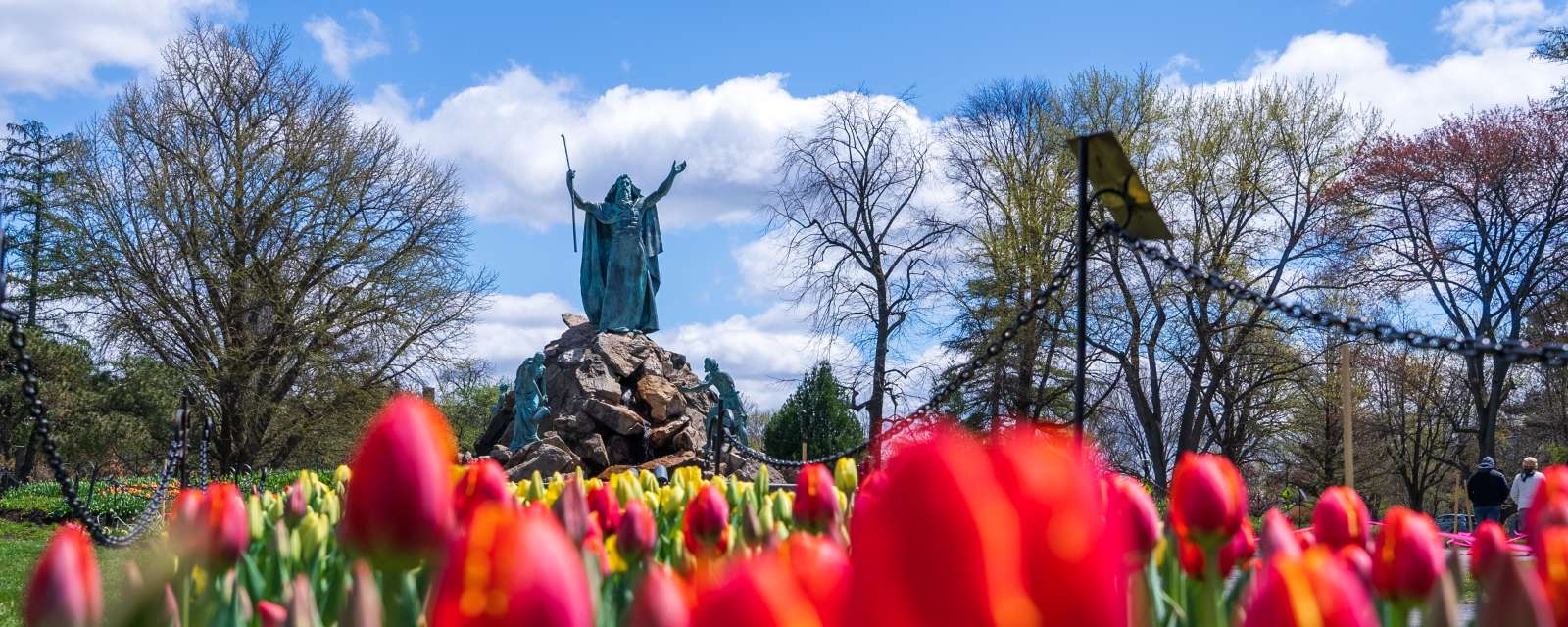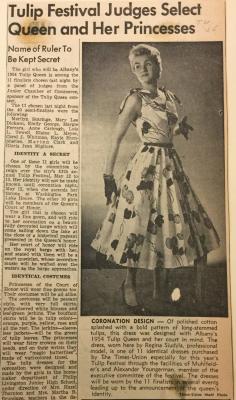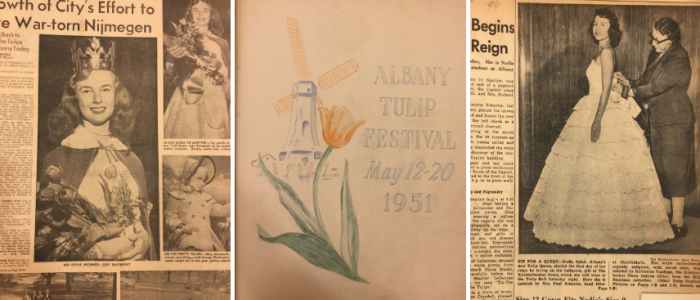
The Albany Tulip Queen is a treasured tradition that dates back to the 1949 Tulip Festival. Through newspaper clippings and photographs from the Albany Institute of History & Art, explore the Tulip Queen's attire and regalia, as well as additional festival fashions, during the first decade of the landmark Albany festival.
Special thanks to the Albany Institute of History & Art for providing the below newspaper clippings and information to make this blog post possible. Interested in learning more about the Tulip Queen's Regalia? Check out this blog post by Curator Diane Shewchuk.
Visit the Albany Institute! Learn more about timed tickets and safety guidelines at this link.
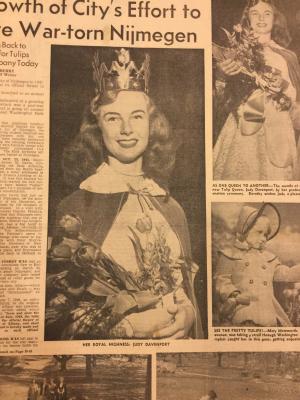
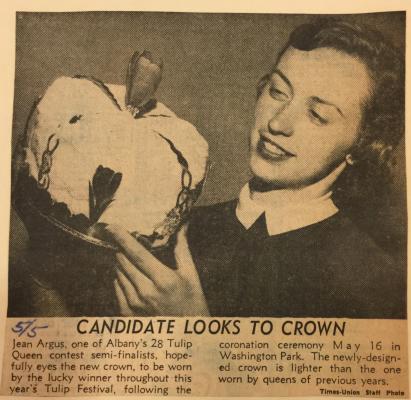
Tulip Queen's Crown
Every queen needs her crown! The history of the Tulip Queen and her crown date back to the 1949 Tulip Festival. Two crowns were designed by Albany Artists Group member artist Hajo Christoph, one for the Tulip Queen and one for the Tulip King. 1949 and 1950 were the only two years that a Tulip King was crowned, but the Tulip Queen tradition continues today. Pictured above (left) is the original Tulip Queen crown, crafted by George Righthand, on the 1951 Tulip Queen Judy Davenport. The three-pound crown was handwrought from brass and copper and featured six tulips standing up from a circlet. Righthand altered the crown in 1955 to have a wider band with rope twisted edges at the bottom, a taller center brass tulip and fur lining. In 1959, retired jeweler Charles Heisler created a new crown out of silver, accented with orange-red enamel tulips, that weighed between twelve to fourteen ounces. This crown is pictured above (right) with Tulip Queen candidate Jean Argus. Both of these crowns are in the Albany Institute's collection.
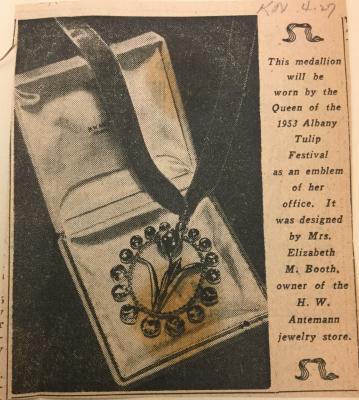

Tulip Queen's Pendant & Royal Scepter
In addition to the crown, the 1950s Tulip Queen regalia included the pendant and the royal scepter. Pictured above (left) is the Tulip Queen pendant that was presented to the 1953 Tulip Queen Peggy Retter as an emblem of her office. The pendant was designed by Elizabeth Booth, owner of H. W. Antemann jewelry store. It was a three-inch oval of twisted gold wire set with amethysts and citrine quartz framing a three-dimensional gold tulip. Over the years, copies and variations of this pendant were given to succeeding queens. The Tulip Queen's regalia also included the royal scepter that was carried for special occasions. Pictured above (right) is the 1957 Tulip Queen Carol Thorsen, with the royal scepter in hand, visiting the children's ward at an Albany hospital. The official royal scepter was topped with an orange and scarlet tulip representing the tulip that Queen Wilhemina of the Netherlands sent to Albany. This tulip, named the Orange Wonder, is the official tulip of Albany!
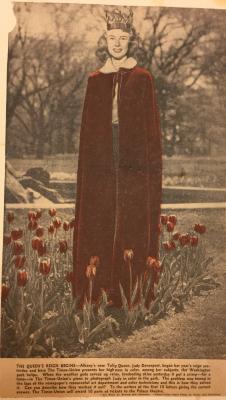
Tulip Queen's “The Crimson Velvet Robe of State”
Throughout Tulip Festival's history, the Tulip Queen wore a red velvet garment that was called a variety of names including a coronation robe, a cape and a mantle. From real fur collars, to silver trims, to white fabric lining, to red fabric lining, the style varied over the years. Additionally, the length of these garments ranged from floor length to knee length. Pictured above is the 1951 Tulip Queen Judy Davenport wearing one of these majestic capes while standing in a Washington Park tulip bed. The Albany Institute's collection includes three of these Tulip Queen capes.
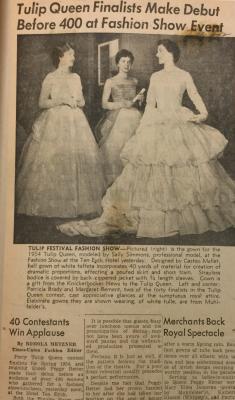
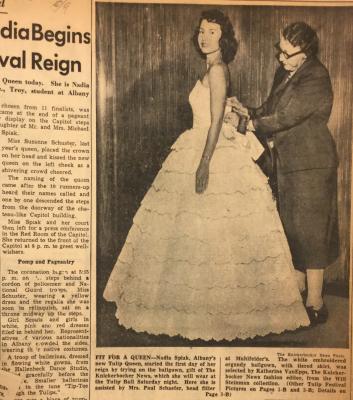
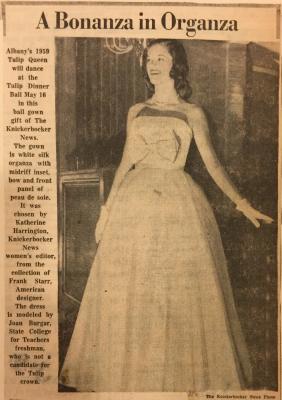
Tulip Queen Ballgowns
Fashionistas will swoon over the glamourous ballgowns worn by past Tulip Queens to official festival events such as the Tulip Ball. Throughout the 1950s, the stunning gowns were gifted by Knickerbocker News and selected for the Tulip Queen by the newspaper's fashion or women's editor. The newspaper article pictured above (left) details the Tulip Festival Fashion Show featuring forty Tulip Queen finalists during the spring of 1954. Sally Simmons, the model on the right of the photo, is wearing the 1954 Tulip Queen white taffeta ballgown designed by Gaston Mallet. Pictured above (center) is the 1956 Tulip Queen Nadia Spiak in a white embroidered organdy ballgown selected by Knickerbocker News fashion editor Katherine VanEpp from the Will Steinman collection. Pictured above (right) is a white silk organza ballgown, modeled by State College for Teachers freshman Joan Burgar, for the 1959 Tulip Queen. The gown was chosen by Katherine Harrington, Knickerbocker News women's editor, from the collection of American designer Frank Starr.
Tulip Queen & Her Court Matching Dresses
The Tulip Queen and her court often wore matching dresses to some of the festival events. Pictured above is professional model Regina Siudyla wearing one of the 11 identical coronation dresses "designed with Albany's 1954 Tulip Queen and her court in mind." The Times-Union purchased these floral dresses for the Tulip Queen and her court from Muhlfelder's, a former downtown Albany woman's clothing store. The dresses are described as "of polished cotton splashed with a bold pattern of long-stemmed tulips." This tradition continues today with the Tulip Queen and her court frequently wearing matching floral dresses to special events, as seen in this Instagram photo from @albanytulipcourt.
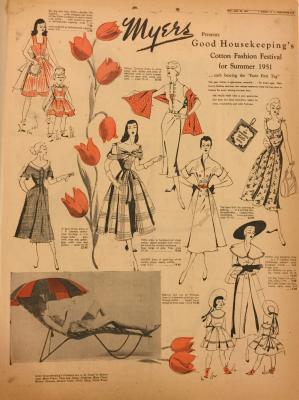
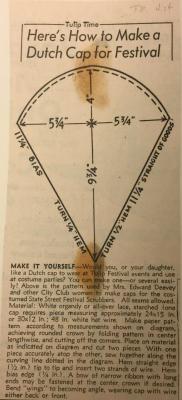
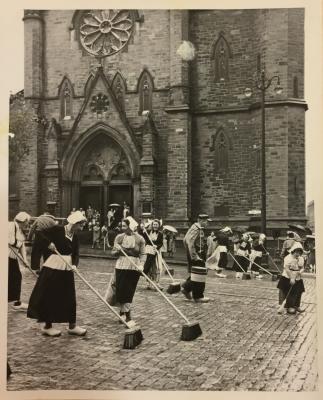
Tulip Festival Fashion Beyond the Tulip Queen
Newspaper articles from the 1950s give a glimpse into Tulip Festival fashion beyond the Tulip Queen and her court. Pictured above (left) is a page from the May 13, 1951 Albany Times-Union featuring "Cotton Fashion Festival for Summer 1951." The page features a variety of cotton dresses that are "glamorous" and "versatile". Pictured above (center) are instructions on how to make a Dutch cap to wear at Tulip Festival events "and use at costume parties." The pattern was used by women of the City Club to make caps for the costumed street scrubbers, pictured above (right). The street scrubbing, a traditional Dutch ceremony, continues to kick off the Albany Tulip Festival every year. From casual fashion, to traditional Dutch garb, these newspapers offer a look at what past Tulip Festival attendees might have worn.
All of the newspaper clippings pictured above are part of the Albany Institute of History & Art's collection. These news clippings were pasted into one of five scrapbooks documenting the Tulip Festival and Tulip Queen, now part of the Albany Institute's collection, assembled by Gerald Luciano in the 1950s.
Do you have any Tulip Festival materials that you are interested in donating to the Albany Institute? Reach out to Curator Diane Shewchuk at shewchukd@albanyinstitute.org or 518-463-4478 ext. 441.
![]()
Celebrate the 2021 Albany Tulip Festival virtually with The City of Albany's Office of Cultural Affairs, Discover Albany, Citizens and The City of Albany Department of General Services with #518TulipTracker. Follow along on social media and use the hashtag to join the conversation.

